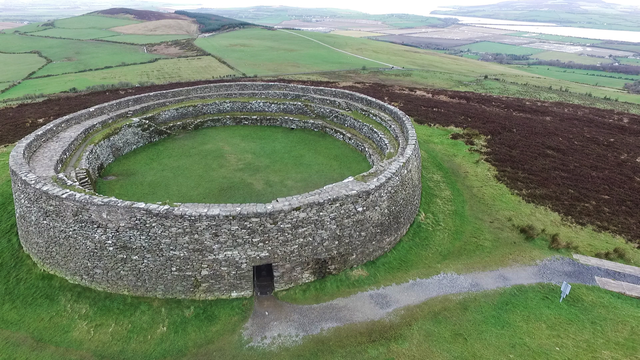The Grianan of Aileach is an ancient hillfort that stands atop the Greenan Mountain on the Inishowen Peninsula in County Donegal, Ireland. This stone fortress, with its origins shrouded in both history and legend, dates back to the early medieval period. It is believed to have been a seat of power for the Kingdom of Aileach, which ruled over parts of Ulster and beyond. The site offers panoramic views of the surrounding countryside, including Lough Foyle and Lough Swilly, making it a strategic location for both defense and control. Over the centuries, the Grianan of Aileach has captured the imagination of visitors with its impressive dry-stone construction and its evocative presence in Irish lore.
Kingdom of Aileach
The Kingdom of Aileach, also known as the Kingdom of Ailech, was a prominent Gaelic political entity in what is now modern-day Northern Ireland and parts of the Republic of Ireland, flourishing from around the 5th century AD until its decline in the 12th century. This kingdom’s timeline is marked by its resilience and strategic importance, nestled in the rich landscapes of Ulster, with its heart often thought to be at the Grianán of Aileach, a hillfort that stands testament to its historical significance.
Aileach’s civilization was deeply intertwined with the Gaelic social structure and culture, characterized by a strong warrior ethos, intricate kinship bonds, and a profound connection to the land. The kingdom played a pivotal role in the power dynamics of early medieval Ireland, often finding itself at the center of major political and military confrontations. Its rulers, belonging to the northern Uí Néill dynasty, were among the most powerful in Ireland, claiming descent from Niall of the Nine Hostages, a legendary 5th-century High King of Ireland.
Religion in the Kingdom of Aileach underwent significant transformation over its existence. Initially, the kingdom’s beliefs were rooted in the pre-Christian pagan traditions of the Gaelic Irish, with a pantheon of gods and a deep reverence for natural and ancestral spirits. However, with the arrival of Christianity in Ireland during the 5th century, introduced by figures such as St. Patrick, the kingdom gradually embraced the new faith. This transition melded Christian beliefs with existing traditions, creating a unique religious landscape.
The social and daily life within Aileach was largely agrarian, with communities engaged in farming, cattle-raising, and crafting. Society was organized around clans and families, with a strong emphasis on loyalty and mutual support. The elite warrior class, including the kings and their retinues, held significant sway, but poets, druids, and craftsmen also enjoyed high status. Feasts, storytelling, and sports like hurling were integral to communal life, reflecting a culture that valued physical prowess, wisdom, and artistic skill.
The rulers of Aileach, primarily from the Uí Néill dynasty, were instrumental in shaping the kingdom’s destiny. Notable kings include Muirchertach Mac Ercae and Domnall Ua Lochlainn, both of whom exerted considerable influence beyond their borders, aspiring to the high kingship of Ireland. Their reigns were marked by ambitious military campaigns, extensive raiding, and significant efforts to consolidate power both within and outside Ulster.
The kingdom’s history is punctuated by numerous wars and battles, reflecting the turbulent nature of early medieval Ireland. Aileach’s warriors participated in conflicts against neighboring kingdoms and Viking invaders, who began raiding the island in the late 8th century. The Battle of Mag Rath in 637 AD, where the forces of Aileach, under King Domnall II, achieved a significant victory against the Ulaid, is among the most celebrated. However, the kingdom’s military prowess could not forever secure its dominion.
The decline of Aileach began in earnest in the 12th century, culminating in its sacking by the Anglo-Norman knight John de Courcy in 1177 AD. This event marked the beginning of the end for the kingdom’s independence, as external pressures and internal strife eroded its power. The once-great kingdom gradually fragmented into smaller territories, each vying for dominance in a changing political landscape.
Despite its fall, the legacy of the Kingdom of Aileach endures in the rich archaeological and historical record, and in the cultural memory of Ireland. Its story is a testament to the resilience and complexity of Gaelic civilization, offering invaluable insights into the social, political, and religious fabric of early medieval Ireland.

